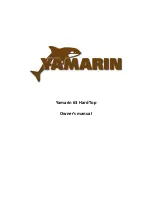
4-1
Table Of Contents
www.SkeeterBoats.com
CONTROLS/INDICATORS
STEERING
Under certain power trim positions of the outboard motor, there can be a noticeable pull on the
steering wheel. This is often referred to as “steering torque.” The position of the outboard motor’s trim
tab affects the amount of steering torque. See your outboard motor operator’s manual for adjustment
of the trim tab. Under any circumstances, the operator should always keep a firm, continuous grip on
the steering wheel.
The owner/operator must inspect the steering system frequently.
• For Cable Steering, check for smooth, free, full range operation and steering components not worn
or loose.
• For Hydraulic Steering, the fluid level should be checked periodically to determine the correct level.
Your Skeeter Dealer should investigate any steering system irregularities immediately. DO NOT
continue to operate the boat if the steering system is malfunctioning.
OUTBOARD MOTOR TRIM
Outboard motor trim is the angular relationship between the lower drive unit of the outboard motor
and the transom of the boat. Boat trim while under way greatly affects your boat’s performance and
efficiency. For best results, the boat should be on plane and trimmed to reduce the wetted surface.
With less boat in the water, both speed and fuel economy increases. Outboard motors with manual
trim must be adjusted for best overall operation for the load and conditions. Outboard motors with
power trim should be adjusted continuously for best results.
If the outboard motor is trimmed in too far (closer to the boat bottom), speed drops, fuel economy
decreases, and the boat may not handle correctly. However, it does provide better acceleration from a
standstill; and because it forces the bow down, visibility is improved. If the outboard motor is trimmed
out too far (away from the boat bottom), steering torque increases, and the boat may be difficult to get
on plane and may bounce.
















































